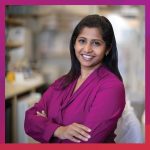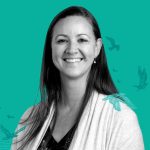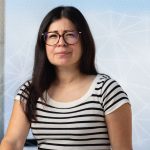Next Gen Melissa Hernandez Horses, hot sauce, and human brain research
Training at Salk brings Melissa Hernandez, a postdoctoral researcher in the lab of Professor Rusty Gage, full circle—she was born in San Diego but cites her early-childhood move north as fundamental to her growth and sense of self.
“When we lived on California’s Central Coast, I loved riding horses and going for bike rides to find wild turkeys and salamanders,” says Hernandez. “And when we came back to San Diego, I got really into dancing—Mexican folk dancing, specifically. I developed a strong love of nature, music, and expression that I brought with me to college.”
When Hernandez got to college, she thought she’d study science-focused documentary filmmaking. Then, a female-physiology course steered her to a premedical degree. The intensely competitive environment quickly soured her interest in premedicine, but she decided to stick with science nonetheless.
Hernandez began her first lab internship as a part of UC Irvine’s Minority Biomedical Research Support program. “I realized you can be so creative in the lab—designing your own questions, plans, and techniques,” recalls Hernandez.
Enamored by research, she decided to spend a summer in a lab in Mexico, where she realized science was like a universal language. This universality, along with noting the enduring enthusiasm of her 70-year-old advisor, prompted her commitment to a career in scientific research.
Hernandez decided to move up the coast to complete her PhD in neuroscience at Oregon Health and Science University (OHSU).
“During my PhD, I forced myself to try everything,” says Hernandez. “I worked briefly with fruit flies, frog eggs, and a few other models, but I kept coming back to neuronal research in mice, and I realized I needed to focus on electrophysiology.”
Electrophysiology is the study of the biological energy exchange that occurs between and within our cells and tissues. In neuroscience, electrophysiology focuses on the electrical pulses between neurons in the brain.
After earning her PhD, Hernandez stayed in Oregon for her first postdoctoral fellowship, after which she took a three-year respite from research. What started as a break to stay home and raise her young children became an action-packed handful of years during which she even founded a hot sauce company.
Hernandez’s partner at the time was from New Orleans, and once she introduced him to Mexican cooking, he created a fusion hot sauce their friends and family loved. The hot sauce became a local success in Portland, but leaping from local to national was unappealing to Hernandez, so she coordinated the end of her hot sauce adventure with her departure from Oregon at the end of 2020.
“…Scientists are inherently creative people—we ask bold questions, take unexpected approaches, and dream really big.”
–Melissa Hernandez
After Oregon, Hernandez returned to San Diego and found herself revisiting a familiar inspiration. “During my time doing research in Oregon, Rusty Gage was like a god to all of us,” Hernandez laughs. “After stepping away from science for those few years, I started reading up on all this new work coming out of his lab at Salk. I was amazed that it was now possible to study the electrical properties of human brains with autism spectrum disorder, Alzheimer’s disease, and beyond.”
Now, Hernandez’s electrophysiology perspective adds meaningful nuance to the Gage lab’s mission to understand age-related cognitive decline. There are many rare diseases with ion channel mutations, which hinder neuronal ability to produce message-sending electrical pulses—Hernandez’s specialty.
Additionally, the lab has been working on improving models of the brain.
“Studying aging in a mouse or rat is challenging because you can’t really capture that fragility, and you can’t see electrical activity either,” says Hernandez. “Rusty has come up with a way to take skin cells from human patients and generate neurons that retain the genetic and epigenetic background of the donor and allow us to start to capture that fragility and electrical activity.”
Genetic and epigenetic preservation means that not only are the genetic instructions for cell behavior intact, but so too are any protein or molecular modifications made to those instructions. This new model allows Hernandez to perform electrophysiological investigation in human tissues that was impossible before.
Beyond the lab, Hernandez is chair of Underrepresented Minorities Advancing Scientific Engagement (URMase), a Salk affinity group that provides support for Salk scientists from backgrounds historically underrepresented in STEM. “I like having a lot of other things going on; that way, when my experiments aren’t going well, I can focus on something else for a bit.”
As Hernandez replants her old San Diego roots, she has begun to find herself again. While she has some new identities, like mother and scientist, she has become reacquainted with old identities, too, like singer and naturalist.
“In some ways, music is just like science,” says Hernandez. “In music, you must listen to a lot of other people’s songs, then stop so you can generate your own. In science, that same process occurs with reading a lot of other people’s research. When you draw that parallel, I think it becomes obvious that scientists are inherently creative people—we ask bold questions, take unexpected approaches, and dream really big.”
Support a legacy where cures begin.
Featured Stories
 Deepshika Ramanan–From iguana poop to breastmilkRamanan, a new assistant professor and microbiologist by training, made a chance discovery about animal gut bacteria that led to her fascination with breastmilk immunity.
Deepshika Ramanan–From iguana poop to breastmilkRamanan, a new assistant professor and microbiologist by training, made a chance discovery about animal gut bacteria that led to her fascination with breastmilk immunity. New strategic plan provides roadmap for enhancing diversity, equity, inclusion, and belonging at SalkGroundbreaking scientific discoveries require talented people behind the scenes, and the more diverse those people are, the more groundbreaking their discoveries. At Salk, improving diversity, equity, and inclusion is a commitment to both scientific discovery and humanity.
New strategic plan provides roadmap for enhancing diversity, equity, inclusion, and belonging at SalkGroundbreaking scientific discoveries require talented people behind the scenes, and the more diverse those people are, the more groundbreaking their discoveries. At Salk, improving diversity, equity, and inclusion is a commitment to both scientific discovery and humanity. Trinka Adamson–Supporting Salk science through animal careAdamson, senior director of Salk’s Animal Resources Department, works to provide the highest quality veterinary medical care, husbandry, enrichment, and professional technical support to enable our scientists to conduct their animal research and make their bold discoveries.
Trinka Adamson–Supporting Salk science through animal careAdamson, senior director of Salk’s Animal Resources Department, works to provide the highest quality veterinary medical care, husbandry, enrichment, and professional technical support to enable our scientists to conduct their animal research and make their bold discoveries. Melissa Hernandez–Horses, hot sauce, and human brain researchHernandez, a postdoctoral researcher in the lab of Professor Rusty Gage, journeyed up and down the west coast and turned from scientist to hot sauce entrepreneur and back before finally settling at Salk to study neuroscience.
Melissa Hernandez–Horses, hot sauce, and human brain researchHernandez, a postdoctoral researcher in the lab of Professor Rusty Gage, journeyed up and down the west coast and turned from scientist to hot sauce entrepreneur and back before finally settling at Salk to study neuroscience. To inspire and educate: Salk’s Education Outreach is on a missionMotivated by Jonas Salk’s admonition to “be good ancestors,” Education Outreach strives to inspire the next generation of scientists. By running programs like the Mobile Science Lab or High School Science Day among others, Education Outreach encourages scientific literacy, enthusiasm in science as a career, and awareness of the value of basic research.
To inspire and educate: Salk’s Education Outreach is on a missionMotivated by Jonas Salk’s admonition to “be good ancestors,” Education Outreach strives to inspire the next generation of scientists. By running programs like the Mobile Science Lab or High School Science Day among others, Education Outreach encourages scientific literacy, enthusiasm in science as a career, and awareness of the value of basic research.




















































